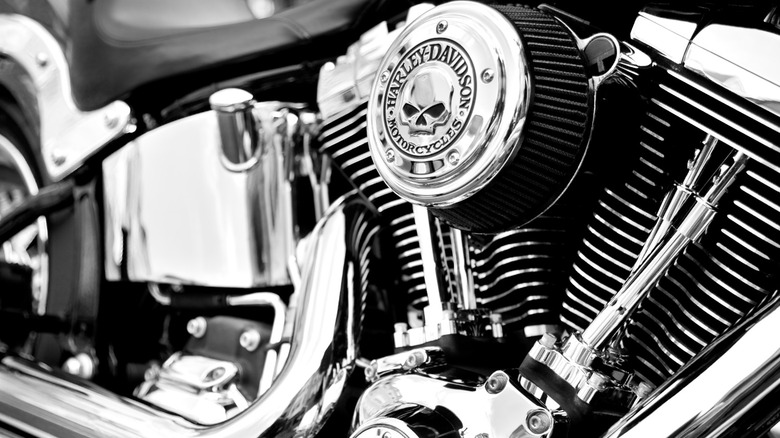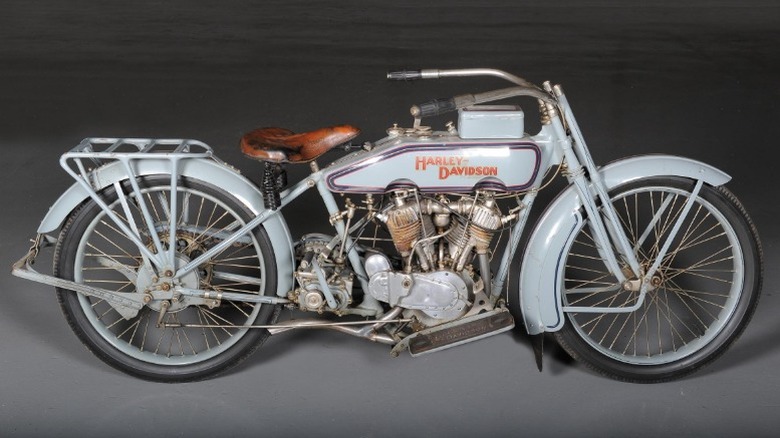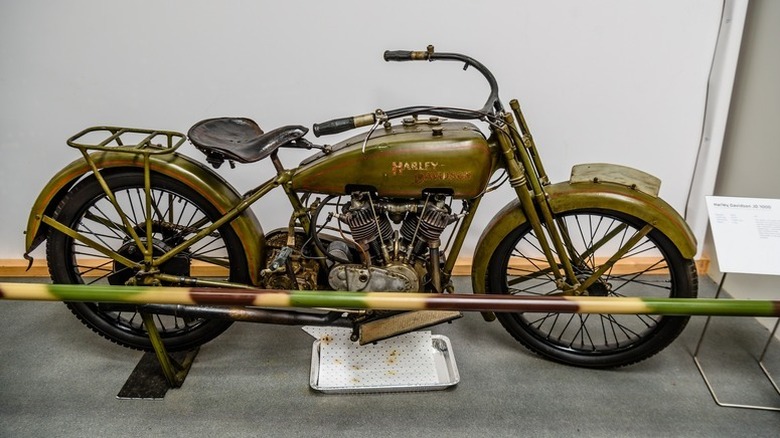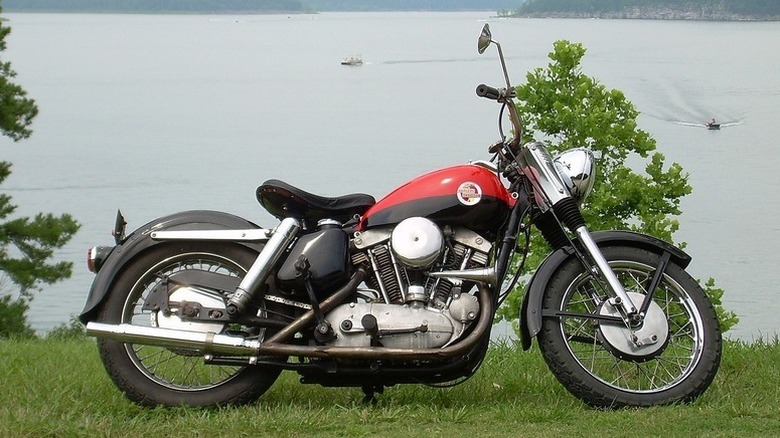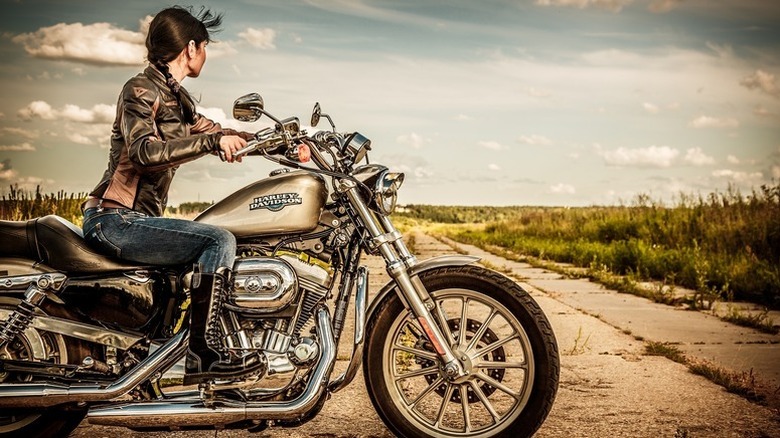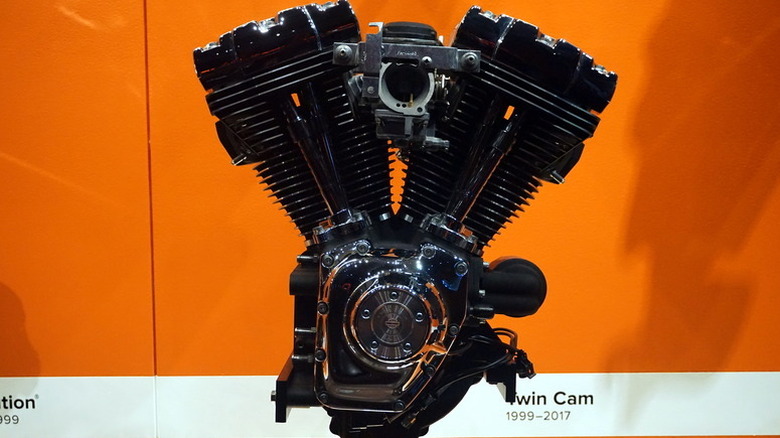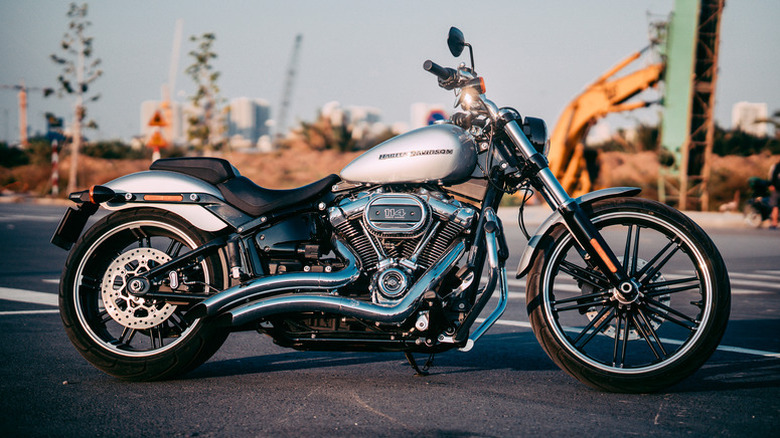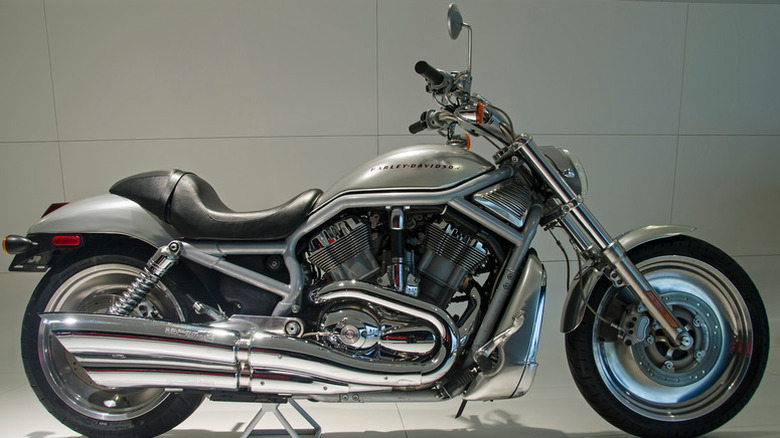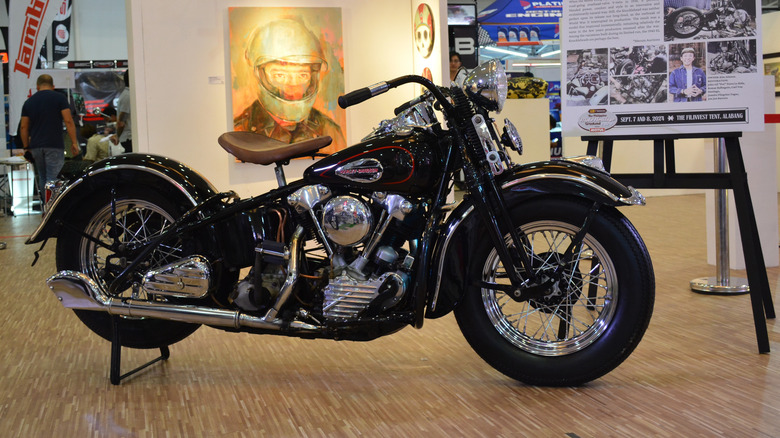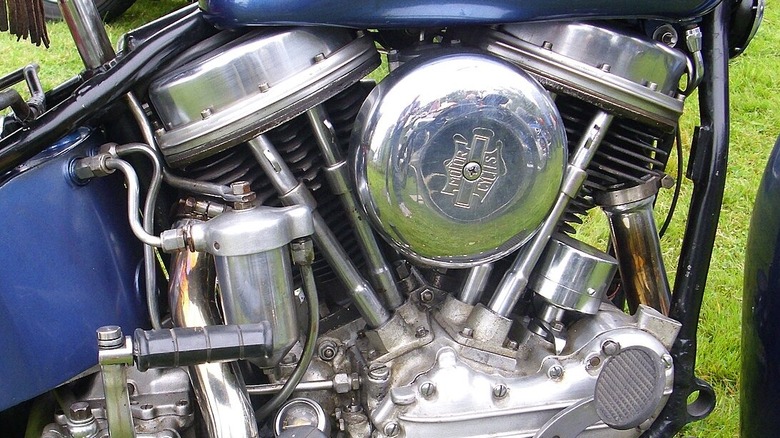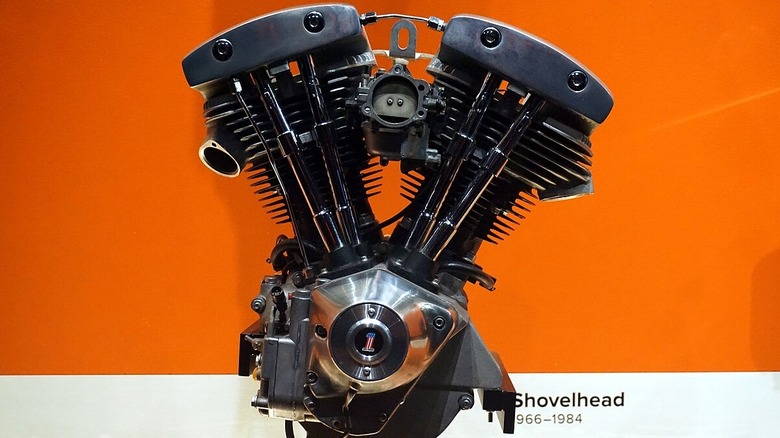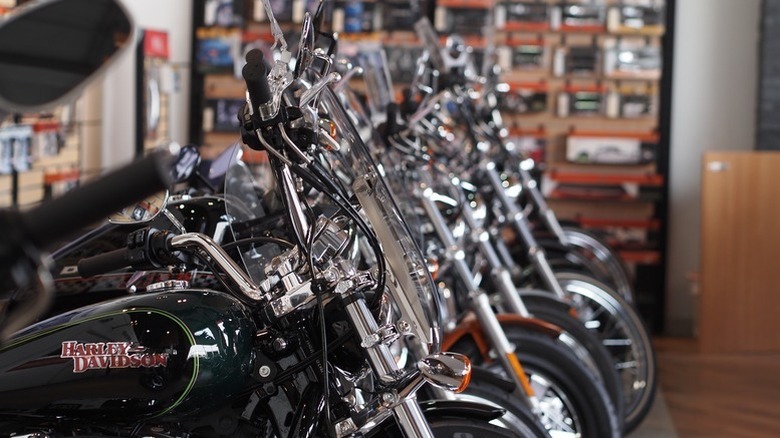10 Of The Best Harley-Davidson Engines Ever Made
Harley-Davidson is one of the most famous and beloved brands on the planet. A dedicated fandom has been buying motorcycles from the Milwaukee-based manufacturer since its inception in 1903. Nearly as old as the internal combustion engine itself, Harley has grown alongside the motorcycle market, inspiring admiration and disdain for its adherence to the V-twin engine.
A common criticism about Harley's preferred power plant is its failure to keep up with the latest technology. A century of development in motorcycle engines, and it sticks with the same configuration it's used since 1909? As much as detractors lament the lack of innovation in Harley-Davidson powerplants, the company's most powerful engines provide a sensory experience that's hard to find elsewhere. The idiosyncratic detonation cycle, classic Harley engine sound, and torquey power that threatens to pull riders off handlebars are all part of the charm.
Harley celebrated its 120th anniversary year in 2023, and it's still delivering bikes (and branded goods) all over the planet. Let's look at a list of some of the best Harley-Davidson engines ever made, examining their reliability, sheer power, longevity, and evolutionary impact on the legendary motorcycle company.
F-Head
The F-Head is the one that started it all. In 1903, William Harley and Arthur Davidson installed a 24.7 cubic inch single-cylinder engine with 3 horsepower into the first Harley-Davidson ever built. With advice from Ole Evinrude of later outboard motor fame, the partners selected an Inlet Over Exhaust engine, known as an F-Head for the shape of its profile.
The single-cylinder F-Head remained the heart of Harley-Davidsons until 1918, but the nascent company used other configurations as well. An F-Head V-Twin with multiple upgraded components and double the cylinders marked a significant improvement in power and reliability. The 61 ci edition is one of the underappreciated aspects of classic Harley-Davidsons, and it ultimately grew into a 74 ci engine — a displacement Harley used for decades.
Though Harley stuck with its V-Twin strategy come hell or high water, the original F-Head was a launching point. Advancing technology and red-hot competition made it obsolete over time, but anyone who has enjoyed a Harley-Davidson built after 1930 owes a debt of gratitude to the original.
An example of a 1916 Harley-Davidson Model 16F Twin Engine is shown above in a photo from a Bonham's auction.
Flathead
Harley-Davidson engineers struck on a winning combination with the flathead engine. Heading into the Great Depression, the once top-of-the-line manufacturer faced stiff competition from the likes of Indian and Excelsior. Engine technology was advancing, but the new overhead valve engines required more metal to produce, thus upping costs.
Harley introduced its 45 cubic inch Flathead engine in 1929, followed by a 74 cubic inch version the following year. Later, an 80 cubic inch version would replace the previous V-series. The Flathead placed the valves in the engine block rather than the cylinder head. Not only was this cheaper to manufacture, but it also proved easier to maintain than more complex overhead valve engines.
Despite the introduction of the Knucklehead in 1936, the Flathead still had a long life ahead. Harley built over 60,000 45 cubic inch flatheads that powered GIs through the battlefields of Europe during World War II, inspiring in many a love for Harley they would take home after the war. The Flathead continued on in the following decades in various Harley-Davidson models despite the rise of overhead valve engines. The last Flathead didn't leave the factory until 1973 — a lifespan of nearly fifty years.
By today's standards, the Flathead engine is downright antiquated, but it gets our nod as one of the best Harley motors ever for its simplicity, reliability, and longevity. After all, it's the longest-produced engine of one of the oldest motorcycle manufacturers in the world.
Ironhead
Speaking of legendary longevity, Harley's Ironhead engine powered bikes from 1957 to 1985, an impressive run that saw it serve as the main powerplant in the longest-continually produced model in the Harley line: the Sportster, one of the best Harley-Davidson motorcycles ever made.
Harley-Davidson needed a light, powerful motorcycle to compete with the British cafe racers fielded by Triumph, BSA, and Norton in the late 1950s. The Sportster was its answer. Powered by a 55 cubic inch overhead valve Ironhead engine with quad cams and a 7.5:1 compression ratio, the Sportster was the first Harley to create one horsepower for every inch of displacement. The new Sportster model was acclaimed by American motorcycling fans, and Harley didn't want to mess with success, leaving the Ironhead largely unchanged for 15 years.
For 1972, Harley upped the displacement to 61 cubic inches and increased compression to 9:1, claiming 61 horsepower. Throughout the 1970s, Ironhead Sportsters became a favorite target of modders who customized them into the choppers and bobbers that would become synonymous with the era. The Ironhead could keep up with imports back in the days before the rise of the superbike. Sportsters achieved favored status amongst Harley fans who wanted something less ponderous than the full-sized behemoths.
While the Sportster continues, the last Ironheads were phased out in 1985. Despite claims to the contrary, Harley does look ahead to see how it can continue to perform against the competition, as proven by its adoption of the Ironhead's replacement, the Evolution Twin, in 1986.
Evolution Twin
In 1969, American Machine and Foundry (AMF) bought Harley-Davidson. Yes, the maker of bowling pins now had one of America's foremost automotive brands in its hands. The results were not good. Harley aficionados often lament the AMF years as the darkest period in the brand's history. After over a decade of flagging reputation, a group of senior executives bought the company out of debt, but it had an uphill battle against claims of poor build quality and reliability. Part of digging itself out of this hole was the introduction of the Evolution Twin (Evo) engine in 1984.
The Ironhead had performed admirably, but the design was rooted in the 1950s, and Japanese bikes were stealing Harley's thunder in the market. The Evo's mission was straightforward: Revitalize Harley's reputation with a modernized take on its V-twin design. The air-cooled Evo utilized aluminum cylinders and heads, reducing wear, improving reliability, and making it significantly lighter than previous engines. Like many classic Harleys, the Ironhead is slowly becoming worth more and more money.
The 1986 Sportster got the new Evo engine — upping the displacement from 1,000 cc to 1,200, setting a trend that would continue for the next couple of decades. Even bigger Evos powered everything from the Softail to baggers, and Harley's reputation and performance bounced back significantly. The last Evolution-powered Sportster rolled off the factory floor in 2022. It's safe to say mission accomplished for the engine that staved off bankruptcy for Harley.
Twin Cam 103
Though the Evolution did its job well, Harley eventually decided it would need something else to power the so-called "Big Twins" — models bigger than the Sportster. In its quest, it introduced the Twin Cam 88 in 1999. The double-overhead-cam (DOHC) engine proved complex and finicky, receiving mixed reviews for its cam chain tensioners, oil leaks, and crankshaft vibration issues. Harley kept working, introducing the Twin Cam 96 as the next evolutionary step.
After a few years of the 96, Harley needed a high-torque upgrade to power its heaviest touring models. It found that increasing the bore and stroke of the 96 to 103 cubic inches brought a 6% increase in torque — perfect for hauling a bagger up and down mountain roads and passing vehicles on open roads.
Riders found that the Twin Cam 103 wasn't perfect, but this reliable motorcycle engine proved a major upgrade over the 88. Harley ultimately adopted it across much of its line. Mated to a six-speed transmission, it produced around 85 horsepower and 100 lb-ft of torque. Most of the production and development issues had been ironed out, and while the time of the Milwaukee 8 fast approached, the 103 proved to be a solid engine, seeing action in the Softail, Dyna, and Touring lines between 2007 and 2012, leaving a solid legacy and a roadway still brimming with 103 powered cruising machines.
Milwaukee Eight
The Milwaukee 8 (M8) is the present and (near) future of Harley-Davidson engines. Only the third complete redesign in the company's history, the eight stands for the number of valves, which aim to improve performance, especially torque, while keeping emissions under control. Introduced in 2017 with a 107 cubic inch model, the Milwaukee, like the Twin Cam 103 before it, was slated for touring models in '17 before making its way to the Softail in 2018.
Producing 10% more torque and 50% more exhaust flow, the 45-degree twin is counter-balanced to address the vibration that has long been a complaint in the Harley world. The M8 has proved to be an ultra-reliable engine. A liquid-cooled 114 cubic inch version currently powers the Ultra Limited and Road Glide models, and it is one of the biggest motorcycle engines ever made.
The larger displacement with cooling can run higher compression ratios — up to 10.5:1 — in the never-ending search for more power. The 2024 big-twin models use some version of the Milwaukee 8, which doesn't look to change soon. Though being out-of-date is a popular charge levied against Harley, its beloved V-twin configuration entered modernity with the Milwaukee 8.
Revolution
The V-Rod was a contentious motorcycle, to say the least. It divided Harley fans into camps; one side embraced something unusual, and the other stuck to Harley-Davidson's traditional guns. After all, what is Harley without the pedigree, the air-cooled twin, and the classic styling?
Developed in part by Porsche, the Revolution engine powering the VRSC — as the V-Rod is officially named — is a 1,130 cc water-cooled V-Twin. Wait a second. Porsche? Water-cooled? What in the world do these words have to do with my beloved Harley-Davidson?
It's a little-known fact that Harley has a history with Porsche dating back to the 70s, and in an attempt to modernize upon its hundredth anniversary the brands collaborated on the Revolution engine. This DOHC, fuel-injected V-Twin put out up to 120 horsepower. The engine was based on the short-lived VR1000 Superbike with a little Porsche engineering to settle it into the tubular frame.
Though the world saw the end of the V-Rod in 2017, there is little debate that the polarizing Harley was a beast, even if it tickled the mustaches of traditionalists a little too hard.
Knucklehead
Harley's history rarely comes up without mention of the Knucklehead. Fondly remembered as one of the first full-sized machines to come out of Milwaukee, contemporary design trends put Knuckleheads in some of Harley's most striking motorcycles.
Harley introduced an overhead valve V-Twin in 1936 to keep up with stiff competition from Indian Motorcycles. Rocker boxes protruding from the head reminded some of a pair of knuckles, and the nickname stuck. Most came tucked into rigid frames with springs beneath the padded seats serving as the only rear suspension. These kidney busters used first 61- and then 74 cubic inch displacements made the robust engine simple to maintain, yet powerful enough for America's burgeoning highway system.
In 1941, Harley switched much of its focus to producing the WLA motorcycle, which it would send to the battlefields of World War II. The flathead WLA performed well, but when production refocused on the domestic front, Harley resumed Knucklehead production until the new Panhead took over in 1948.
Harley-Davidson Knuckleheads are highly sought after in the collectible motorcycle market, accounting for some of the rarest survivors. The relatively brief 12-year production pales in comparison to other engine runs, and the pure Americana vibe of the time period is a treat for the eyes, if not the rear end.
Panhead
The Panhead arrived in 1948. It is the earliest Harley engine to take the familiar look of its more modern engines. Its nickname came courtesy of redesigned rocker covers that looked like cooking pans turned upside down. Soldiers who had ridden Harleys had spending power, and they wanted more refined and ever-powerful bikes.
Under the Panhead, Harley-Davidson became a cultural institution as American society explored a new Cold War world. Veterans of the Korean and Second World Wars who missed the camaraderie of the military purchased Panheads and began riding together, unwittingly creating an enduring biker culture in the United States. The 1956 National Interstate and Defense Highways Act fired up the construction equipment, and the roads of America were never more open. Dennis Hopper and Peter Fonda oozed the new counterculture on a pair of customized Panhead choppers — one, the Captain America bike, painted in stars and stripes livery — in 1969's "Easy Rider." The Panhead was as American as Harley had ever been.
The Panhead was the final full-sized kick-start engine Harley produced. The final year of the Panhead — 1965 — was the first year of the electric start. It had seen the veterans of the Cold War returning from their various battlefields and left an outsized cultural imprint.
Shovelhead
As went the Knucklehead, so too did the Panhead. Harley's Shovelhead would have to be named after its head — it was tradition by the time it came out in 1966. The debut Shovelhead used the 74-cubic-inch V-Twin configuration Harley had made so much hay from over the decades, and was a success among Harley fans, but the new engine wasn't the only reason.
Harley overhauled the suspensions on its bike, updating and improving long-overlooked aspects of the Harley experience. Electric start was now a thing — no Shovelheads produced after 1970 were kick-start. Sumptuous seats, candy paint, voluminous saddle bags, and windshields adorned the Shovelhead Harleys. By the final year of the Shovelheads run in 1985, Harley-Davidson saw a sales increase of 26%.
Of course, the 20-year career of the Shovelhead wasn't all roses. American Machine Foundry (AMF) purchased Harley in 1969, and the Shovelhead sailed into the frenetic '70s, but fell victim to the 1974 gas crisis. Inferior gasoline caused excessive heat, which expanded aluminum internals and melted gaskets. None of this helped AMF's fast-deteriorating foray into motorcycle production, which was marred by build-quality issues. By the time AMF sold the faltering company to a buyer group led by Willie G. Davidson in 1981, the Shovelhead was on its way out.
Methodology
Motorcycles are built for many purposes, and calling one engine better than the other is an exercise in subjectivity — especially amongst the passionate fanbase of Harley riders. We judged these engines based on a holistic approach, examining power, reliability, longevity, and their place in the evolution of Harley-Davidson powerplants.
There can be arguments made to lose any of these engines and replace them with another one of the Harley line, but it's tough to argue with the fact that each of these motors has its place in the pantheon of motorcycle greatness.
